Link para o artigo original : https://www.bridgewater.com/research-and-insights/an-update-from-our-cios-the-tightening-cycle-is-beginning-to-bite
April 14, 2023
Last year’s historically large and rapid tightening is starting to constrict the financial system and slow the economy. This is necessary and will need to be sustained to restore equilibrium conditions.
The tightening cycle began roughly one year ago. It takes about that long for a tightening to have significant economic impacts, and signs are emerging that the effects are now spreading and deepening. Damage to the banking system is a manifestation of the tightening and is now likely to be a contributor. Economies rely on the steady flow of liquidity from cash and credit to assets and spending. This liquidity pipeline runs from the central bank as the originator, through the financial system as an intermediary, to the markets, and finally to spending and income. The combination of central banks raising interest rates and draining reserves with banks experiencing more constrained deposit and capital conditions and now tightening credit standards is very likely to constrain the flow of money and credit to markets and the economy, with impacts on spending and income. Manifestations of this are now showing up in the data, as we’ve described in recent research.
Stepping Back, the Most Basic Problem to Recognize Is That Economies and Markets Are Far from Equilibrium Conditions
In brief, we believe that there are three major equilibriums and two major policy levers that interact to drive markets and economies. As outlined in previous research, we see the three equilibriums as:
- Spending and output in line with capacity, which roughly translates into something like 2% real growth with 2% inflation, 4-5% nominal spending growth consistent with that, and an unemployment rate that’s around average.
- Debt growth in line with income growth, meaning credit growth that’s not too high and not too low, with interest rates that act as neither a major incentive nor disincentive to borrow.
- A normal level of risk premiums in assets relative to cash, meaning bonds provide an expected return above cash, and equities an expected return above bonds, commensurate with the risks of those assets.
If these conditions don’t exist, intolerable circumstances will ensue that will drive changes toward these equilibriums being reached. For example, if an economy’s usage of capacity (e.g., labor and capital) remains low for an extended period of time, that will lead to social and political problems as well as business losses, which will produce further changes until these equilibriums are reached.
The two levers are monetary policy and fiscal policy. Monetary policy is managed by central banks to drive money and credit changes that finance the purchases of goods, services, and financial assets. Fiscal policy is managed by the legislative and executive branches of governments to use taxes, government spending, and laws and regulations to influence economic behavior. Structural reforms are changes in laws and regulations, so they occur via fiscal policies.
All the economic and market swings that we see reflect the never-ending struggles of the marketplace and of policy makers (using these levers) to bring these equilibriums about. We see this reflected in economic and market swings that occur around income and productivity trends. For example, while over the long run one’s spending must converge toward one’s income and one’s income will rise as a function of one’s productivity, over the short run spending can diverge significantly from one’s income as a function of taking on or paying back debt. By watching where we are relative to these equilibriums, we try to anticipate what levers will have to be moved in which ways, and by watching how the levers are moved, we try to anticipate market and economic changes.
We’re Far from Equilibrium in the West, Closer to Equilibrium in the East
The closer an economy is to equilibrium, the easier it is to fix problems and the lower the volatility of markets. The further an economy is from equilibrium, the bigger the policy moves required to fix problems and the higher the market volatility. Within our systems, we measure the degree to which an economy is near or far away from equilibrium and connect that to the policy responses and the market movements that normally result. As we’ve described in previous research, the greatest disruption of equilibrium today remains the high level of nominal spending, which, when compared to the ability of the economy to produce more, leads to inflation rates that are significantly above target.

Aggregating a number of indicators of equilibrium conditions, the following chart shows the degree to which the US, Europe, and the UK have veered away from equilibrium. These economies remain quite far from equilibrium for similar reasons, and this is leading to big policy shifts and high market volatility. Furthermore, despite aggressive policy action, they have not moved much closer to equilibrium. On the margin, the nature of the disequilibrium has shifted from too much inflation to not enough growth, with the risk premiums on assets falling relative to cash.
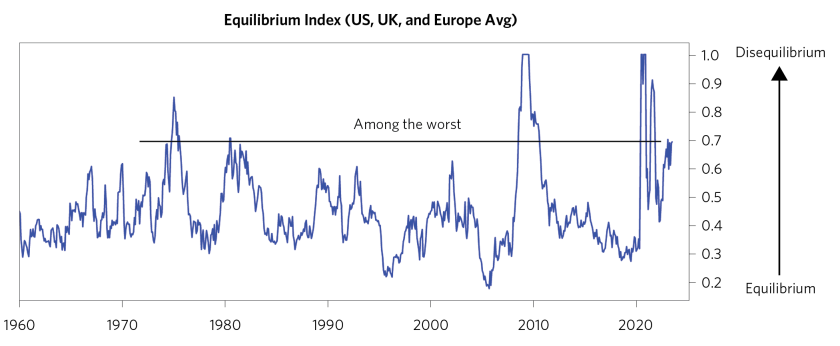
In Japan and China, because spending is more aligned with labor output, inflation is under control, giving policy makers room to support economies and markets.
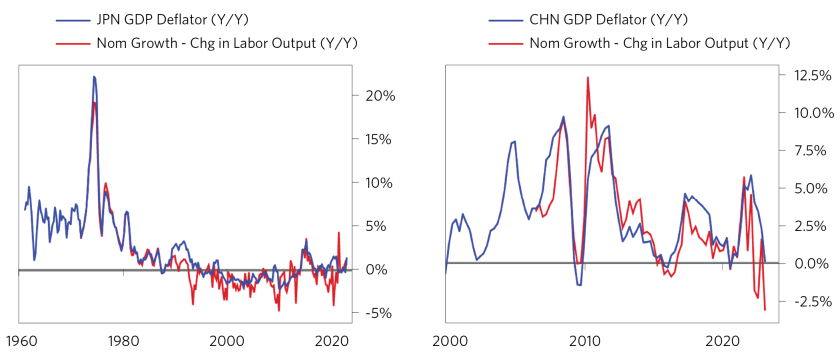
Conditions in Japan are much closer to desired equilibrium.
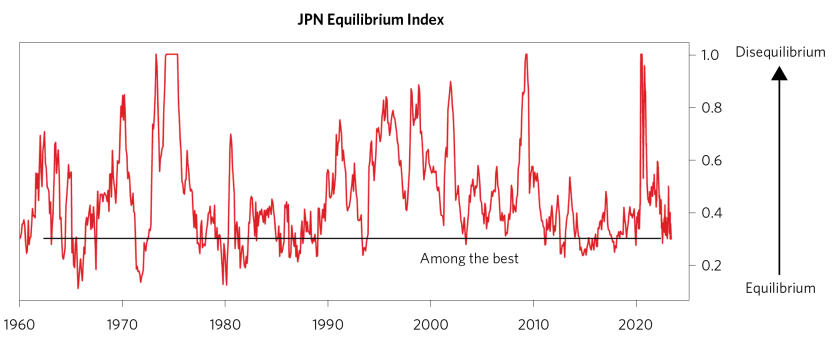
The path from disequilibrium to equilibrium allows for big swings in markets, which can be in either direction, so this is not a good short-term timing measure. But it is a frame of reference for longer-term positioning that has a good track record. For example, the following table shows the average returns of assets across various stages, divided into bullish disequilibriums, which typically lead to stimulative policies that are supportive to assets; bearish disequilibriums, which generally require tighter policies and are bad for assets; and near-equilibrium conditions, where volatility is lower and you are likely to earn a normal risk premium on assets held.

Taking a look at why we are now in the bearish disequilibrium, the following table summarizes a few key measures for the US economy. With respect to the economy, the inflation rate is too high, the rate of nominal spending is too high to bring that down, the rate of unemployment is too low to bring wages down, and despite nominal growth being too high, the real growth rate is lower than desired. Of course, a weaker real growth rate is required to resolve the other imbalances, but that is a form of disequilibrium on its own, illustrating the challenge of having to create one disequilibrium in order to resolve another, and then iterating back and forth as policy makers try to bring all of them in line.
With respect to the markets, bond yields are too low in relation to cash and discounted inflation rates are well below current and projected inflation rates, so there is no risk premium in bonds. There is a roughly normal risk premium in equities relative to bonds based on current earnings and the current bond yield. But if you get a recession as needed to get the desired inflation rate, earnings would be about 20% lower, making the earnings yield too low in relation to bonds at the same time as the bond yield is too low in relation to cash. In other words, in order to deal with today’s economic disequilibriums, central banks are having to make cash very attractive, which is making bonds and stocks unattractive in relation to cash. At the same time, nominal spending is too high and the labor markets are too tight to allow for the easing of policy that is priced into the front of the yield curve, which is the easing that would be necessary to provide for a normal risk premium in bonds.
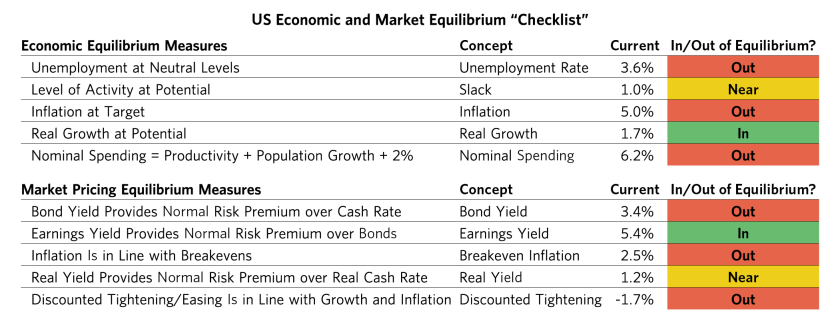
When you add up this picture, you can see why the degree of disequilibrium is so high and why we favor cash in relation to assets in most developed economies until these imbalances are closer to being resolved. On the other hand, we favor assets in relation to cash in Japan, China, and much of Asia because they are either closer to equilibrium or are in disequilibriums that favor an expansion of liquidity that makes cash unattractive in relation to assets.
Where We Are on the Path to Equilibrium
As described in previous research, we outlined what we see as the path to equilibrium:
- In order to have a sustainable 2% inflation rate at a 2% real growth rate, you need wage growth to fall to around 2.5%.
- To reduce wage inflation, you need to cut nominal spending and income growth in half to 3-5% and raise the unemployment rate by 2% or more (P=$/Q).
- To raise the unemployment rate, you need to drive nominal GDP growth materially below wage growth, compressing profit margins enough to produce about a 20% decline in earnings.
- Then central banks need to remain restrictive for about 18 months, until 2% wage growth is achieved.
- Then they can restore a normal yield curve and risk premium in bonds by cutting short-term interest rates to about 1% below bond yields.
Updating that picture, what has happened is that we have moved incrementally in the direction of an economic contraction with a slight moderation in inflation. The cracks in the banking system are a move in that direction and are a direct result of the aggressive easing and then aggressive tightening of monetary policy.
The easing pushed a lot of liquidity into banks via zero-yielding deposits, and given the lack of loan demand at the time, the liquidity went into bonds at very low yields. The subsequent tightening and rise in short-term interest rates are now causing disintermediation of those low-yielding deposits, replaced by deposits and borrowing at market yields that are higher than the yields on the bonds purchased, causing losses on a mark-to-market basis and on an accrual basis over time. At the same time, there is a tightening of credit standards, which is threatening credit losses at a time when earnings power is diminished by the upside-down bond holdings. This is passing through to a slowing of credit into the economy and a weakening of banks’ ability to cushion a downturn.
We are also seeing the first signs of a rise in savings rates that would be more consistent with the past year’s rise in interest rates and weakening of asset markets. This month’s ISM survey was the first that showed both a weakening of orders and a weakening in employment. The JOLTS figures also showed a drop in job openings. And business loan demand has collapsed. These are all signs that the tightening is passing through to the economy. This raises the odds of a pause in the tightening cycle, but at the cost of a decline in earnings and a rise in risk premiums.
It takes big moves over a sustained period of time to restore equilibriums once they have deviated substantially from desired levels. The following charts update some of the key characteristics and influences that we outlined in prior research.
Broad inflation and the wage inflation around which it is anchored have moderated a bit, but both remain significantly elevated relative to equilibrium levels.
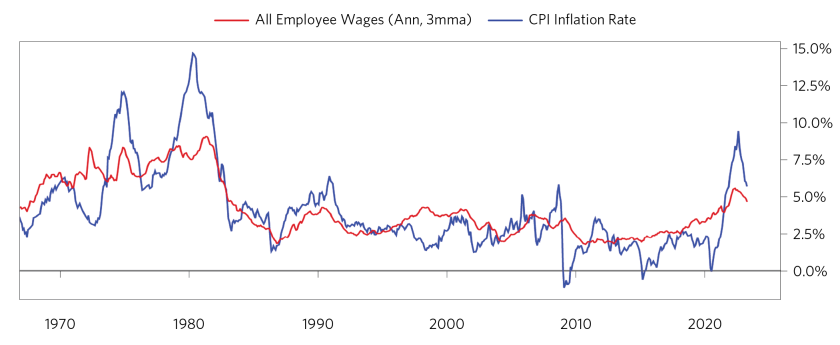
Nominal spending, fueled by the wages that consumers earn, is running close to 8%, above the roughly 5% in the recent decades of subdued inflation. Subtracting out 2% as a rough estimate of the economy’s long-term real growth potential, that corroborates the inflation rate around 6% that we see today.
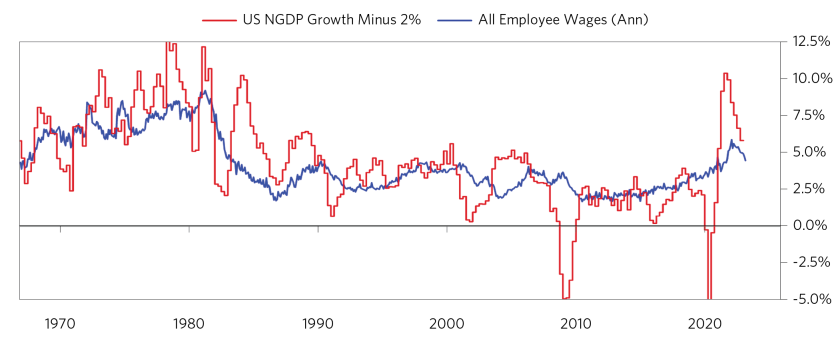
Wages are simply a price set by the supply and demand of labor. The supply/demand balance today does not resemble the conditions that led to past wage declines.
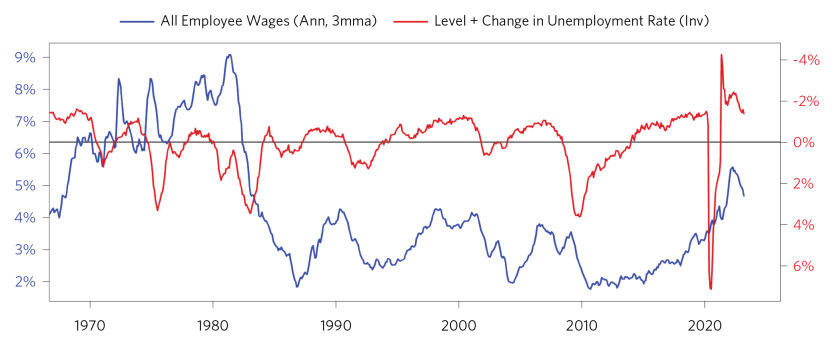
The spread between nominal spending and wages (red line below) is a good proxy for economy-wide corporate profits, and that positive spread incentivizes hiring and additional wage pressure. While the spread between nominal spending and wages has ticked down modestly, it remains positive.
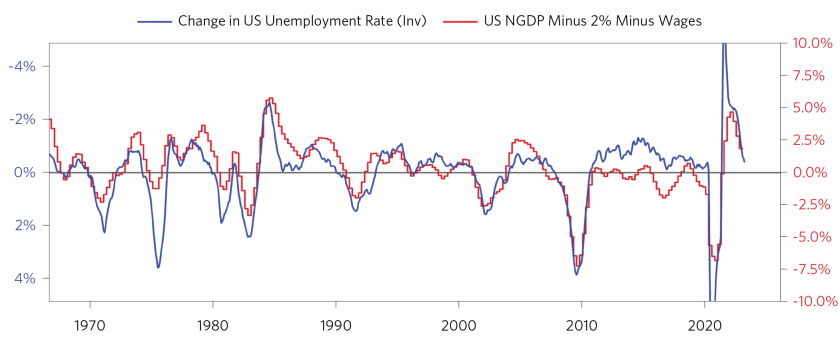
Looking directly at corporate profits shows a bit more progress toward equilibrium, but we estimate corporate profits need to fall roughly 20% and are currently down a bit less than 10%. More pain is needed to raise unemployment, reduce wages, and moderate inflation.
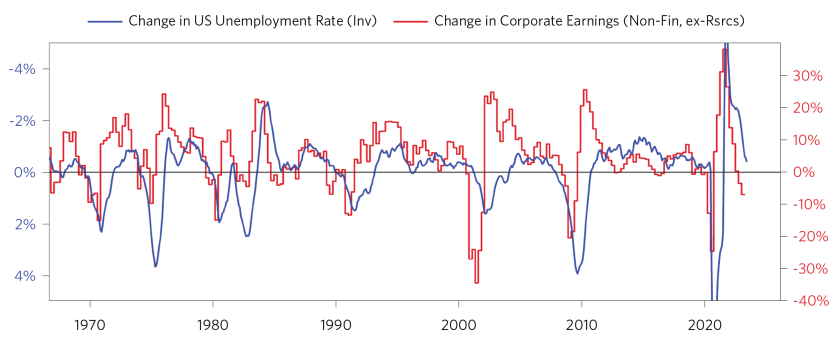
Traversing the Cycle: What Comes Next
The levels of economic conditions and market pricing as described above reflect whether the system is near equilibrium. The changes in policies and conditions along the way indicate what comes next. The cycle diagram below illustrates the typical sequence of changes pertaining to expansions and contractions of liquidity that drive near-term changes in economic conditions and asset pricing. As shown, across most of the developed economies of the West, tightenings of monetary policy have reversed the flow of liquidity and driven money from assets to cash. That tightening has driven up discount rates (i.e., the discounted real yield of cash) but so far hasn’t had much impact on risk premiums or growth. That is likely what comes next. In contrast, Japan, China, and much of the East are in the opposite stage of the cycle where policy makers are supporting the flow of money and credit, which lowers discount rates and risk premiums and supports growth.
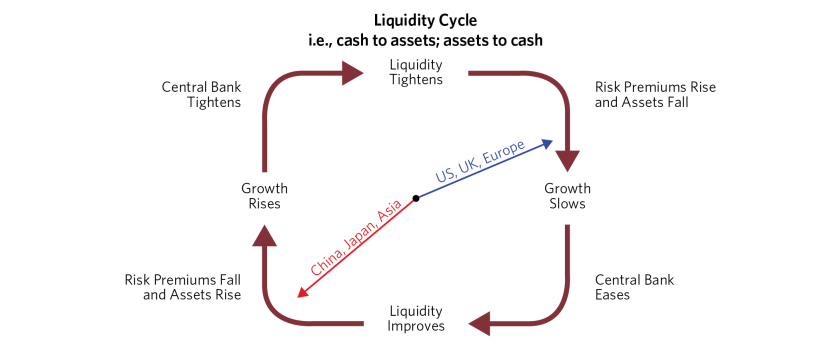
Relating the liquidity cycle to asset returns, in the West, the coming stage is bad for stocks and less bad for bonds than where we’ve been.
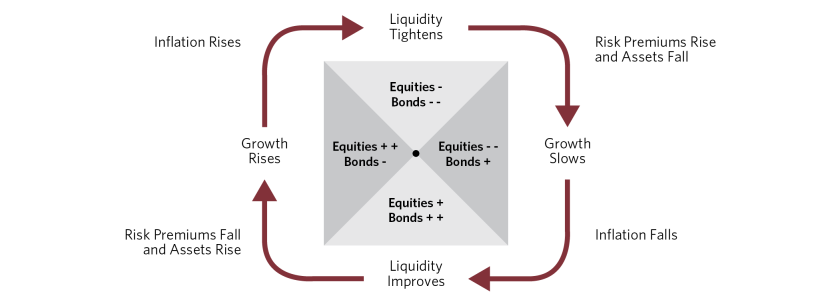
The Dollar Is Vulnerable and Pressures Are Reversing
The dollar has experienced three stages of influence since the pandemic. First, the spillover of very aggressive monetization of government debt (MP3) produced outflows from dollars. Then, the strong growth rates that resulted from these policies caused US equities and the US economy to be the strongest in the world, which attracted capital into the dollar. Then, the tightening of monetary policy by the Fed was the most aggressive in the world and pulled another round of capital into the dollar, sent the real exchange rate to the top of its 50-year trading range, and pushed the current account into substantial deficit. The current account deficit represents the breakeven capital inflow to hold a currency steady, meaning that a given level of capital inflow is discounted to continue once it impacts the currency and the capital account. The resulting level of the exchange rate can be sustained if conditions are sustained. But if conditions change, capital flows change as well. Given the next stage of the cycle, a weakening of the US economy will make US assets less attractive, particularly if the Fed pauses or eases while Asian economies recover and the ECB continues to tighten monetary policy to catch up. So, the dollar is vulnerable as relative conditions and policies reverse.
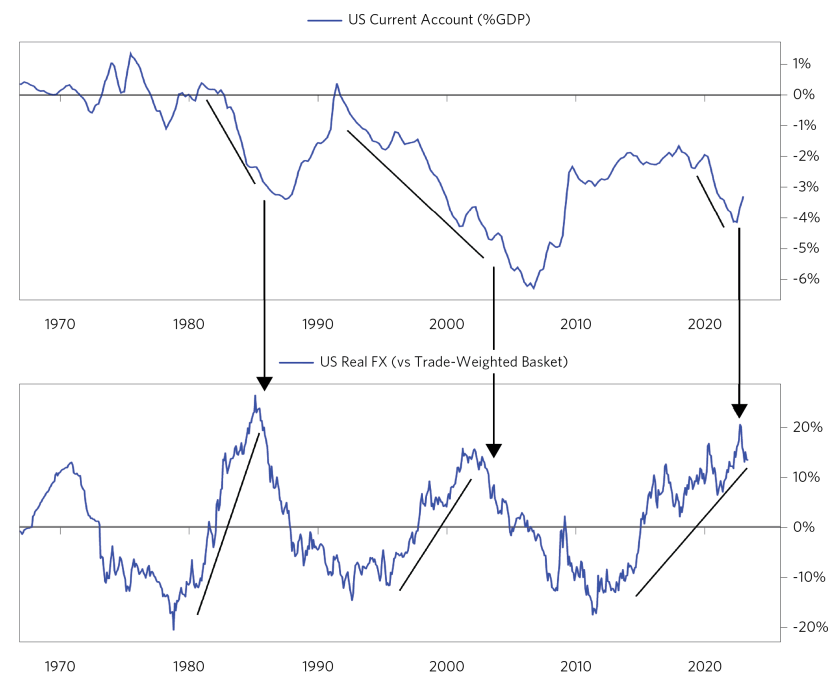
IMPORTANT DISCLOSURES AND OTHER INFORMATION
Information contained herein is only current as of the printing date and is intended only to provide the observations and views of Bridgewater Associates, LP (“Bridgewater”) as of the date of writing unless otherwise indicated. Bridgewater has no obligation to provide recipients hereof with updates or changes to the information contained herein. Performance and markets may be higher or lower than what is shown herein and the information, assumptions and analysis that may be time sensitive in nature can change materially and may no longer represent the views of Bridgewater. Statements containing forward-looking views or expectations (or comparable language) are subject to a number of risks and uncertainties and are informational in nature. Actual performance could, and may have, differed materially from the information presented herein. Past performance is not indicative of future results.
The views expressed herein are solely those of Bridgewater and are subject to change without notice. In some circumstances Bridgewater submits performance information to indices, such as Dow Jones Credit Suisse Hedge Fund index, which may be included in this material. You should assume that Bridgewater has a significant financial interest in one or more of the positions and/or securities or derivatives discussed. Bridgewater’s employees may have long or short positions in and buy or sell securities or derivatives referred to in this material. Those responsible for preparing this material receive compensation based upon various factors, including, among other things, the quality of their work and firm revenues.
Bridgewater research utilizes data and information from public, private, and internal sources, including data from actual Bridgewater trades. Sources include BCA, Bloomberg Finance L.P., Bond Radar, Candeal, Calderwood, CBRE, Inc., CEIC Data Company Ltd., Clarus Financial Technology, Conference Board of Canada, Consensus Economics Inc., Corelogic, Inc., Cornerstone Macro, Dealogic, DTCC Data Repository, Ecoanalitica, Empirical Research Partners, Entis (Axioma Qontigo), EPFR Global, ESG Book, Eurasia Group, Evercore ISI, FactSet Research Systems, The Financial Times Limited, FINRA, GaveKal Research Ltd., Global Financial Data, Inc., Harvard Business Review, Haver Analytics, Inc., Institutional Shareholder Services (ISS), The Investment Funds Institute of Canada, ICE Data, ICE Derived Data (UK), Investment Company Institute, International Institute of Finance, JP Morgan, JSTA Advisors, MarketAxess, Medley Global Advisors, Metals Focus Ltd, Moody’s ESG Solutions, MSCI, Inc., National Bureau of Economic Research, Organisation for Economic Cooperation and Development, Pensions & Investments Research Center, Refinitiv, Rhodium Group, RP Data, Rubinson Research, Rystad Energy, S&P Global Market Intelligence, Sentix Gmbh, Shanghai Wind Information, Sustainalytics, Swaps Monitor, Totem Macro, Tradeweb, United Nations, US Department of Commerce, Verisk Maplecroft, Visible Alpha, Wells Bay, Wind Financial Information LLC, Wood Mackenzie Limited, World Bureau of Metal Statistics, World Economic Forum, YieldBook. While we consider information from external sources to be reliable, we do not assume responsibility for its accuracy. Data leveraged from third-party providers, related to financial and non-financial characteristics, may not be accurate or complete. The data and factors that Bridgewater considers within its investment process may change over time.
This material is for informational and educational purposes only and is not an offer to sell or the solicitation of an offer to buy the securities or other instruments mentioned. Any such offering will be made pursuant to a definitive offering memorandum. This material does not constitute a personal recommendation or take into account the particular investment objectives, financial situations, or needs of individual investors which are necessary considerations before making any investment decision. Investors should consider whether any advice or recommendation in this research is suitable for their particular circumstances and, where appropriate, seek professional advice, including legal, tax, accounting, investment or other advice.
The information provided herein is solely a guide to current expectations and not intended to provide a sufficient basis on which to make an investment decision and investment decisions should not be based on simulated, hypothetical or illustrative information that have inherent limitations. Simulated or hypothetical information are limited in part because they are based on a variety of criteria and assumptions, which might vary substantially, and involve significant elements of subjective judgment and analysis that reflect Bridgewater’s own expectations and biases, which might prove invalid, inaccurate or change without notice. Unlike an actual performance record, simulated or hypothetical results do not represent actual trading or the actual costs of management and may have under or over compensated for the impact of certain market risk factors. For these reasons, simulated or hypothetical information typically shows better results than can be achieved through actual trading. Bridgewater makes no representation that any account will or is likely to achieve returns similar to those shown, and actual returns might be substantially lower. The price and value of the investments referred to in this research and the income therefrom may fluctuate.
Every investment involves risk and in volatile or uncertain market conditions, significant variations in the value or return on that investment may occur. Investments in hedge funds are complex, speculative and carry a high degree of risk, including the risk of a complete loss of an investor’s entire investment. Past performance is not a guide to future performance, future returns are not guaranteed, and a complete loss of original capital may occur. Certain transactions, including those involving leverage, futures, options, and other derivatives, give rise to substantial risk and are not suitable for all investors. Fluctuations in exchange rates could have material adverse effects on the value or price of, or income derived from, certain investments.
This information is not directed at or intended for distribution to or use by any person or entity located in any jurisdiction where such distribution, publication, availability or use would be contrary to applicable law or regulation or which would subject Bridgewater to any registration or licensing requirements within such jurisdiction.
No part of this material may be (i) copied, photocopied or duplicated in any form by any means or (ii) redistributed without the prior written consent of Bridgewater ® Associates, LP.
©2023 Bridgewater Associates, LP. All rights reserved.

